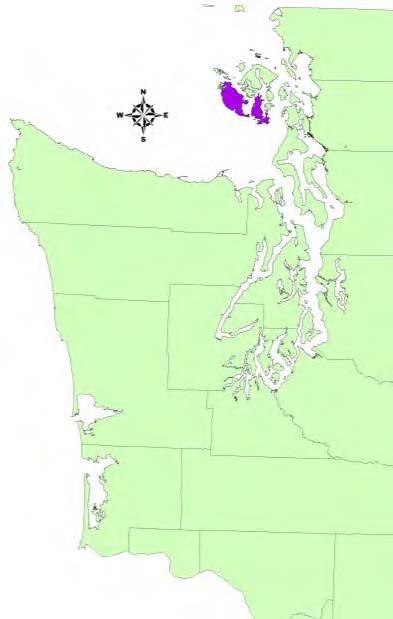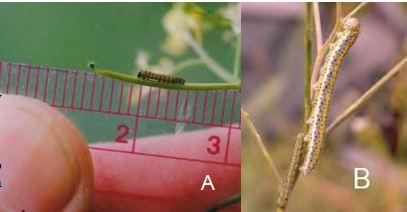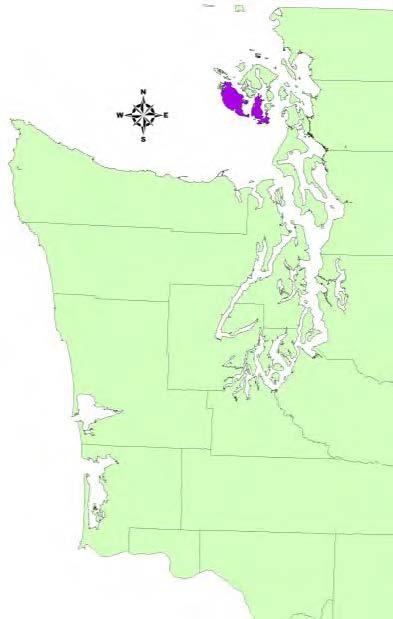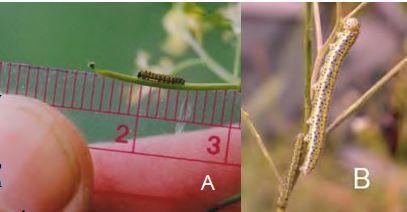Island Marble (Euchloe ausonides insulanus)
This article was originally published by the Washington Department of Fish and Wildlife as part of its annual report Threatened and Endangered Wildlife in Washington.

State Status: Candidate, 2002
Federal Status: Species of concern
Recovery Plans: None
The island marble is a rare, medium-sized (~2.5 inches) butterfly restricted to San Juan and Lopez islands in northwestern Washington (Figure 1). It is a subspecies of the more widely distributed large marble (E. ausonides; Guppy and Shepard 2001). Adult island marbles are on the wing early-to-mid April to mid-June. Females select specific plants and species within the mustard family (Brassicaceae) to lay their eggs. Island marbles were originally known from 14 specimens from southwestern British Columbia collected between 1861 and 1908 (Shepard 2000), and were believed extinct until rediscovered at the American Camp Unit of San Juan Island National Historic Park (NHP) in 1998 (Fleckenstein and Potter 1999). Surveys conducted since then have helped expand knowledge of the island marble’s range, flight period, host plant requirements, and natural history, and have identified threats to its conservation. Lambert (2011) termed the island marble a “colonizing species” because its larvae feed on host plants that are early successional species that densely colonize disturbed soil, and die out over time. The island marble must disperse from declining host patches to newly colonized sites.
Population status. Surveys have been conducted in Washington and British Columbia to determine the distribution of the island marble. WDFW led survey efforts to determine the distribution of this butterfly within Washington from 2005 to 2012. Visits to over 240 potential locations in the San Juan Islands, Olympic Peninsula, and northern coastal Puget Sound, resulted in documenting locations only on San Juan and Lopez islands. WDFW annually monitored the species and habitat status at the known sites from 2005 to 2012 in cooperation with private landowners, the National Park Service, Bureau of Land Management, Washington Department of Natural Resources, and San Juan County. Surveys from 1998 to 2011 identified 52 island marble sites representing five populations on the two islands. Over the past few years, however, it has become clear that the majority of sites that were previously occupied no longer support this butterfly. The number of populations and individuals has declined significantly over the last 5 years; most butterflies now occur within San Juan Island NHP. In 2011, 17 sites occupied in prior years were searched (14 on San Juan Island and 3 on Lopez Island). The butterfly was detected at 4 sites, including two locations in San Juan Island NHP. No island marbles were detected on Lopez Island in 2011, but larvae were found at one site there in 2012. In 2012, island marbles were detected at 6 sites, with the highest numbers at 2 in San Juan Island NHP. San Juan Island NHP is the remaining stronghold for this butterfly and park staff are considering a number of efforts to protect and expand populations. Annual monitoring detected a >70% decline in island marble adult encounter rate on two of three transects in the park between 2004 and 2011 (Lambert 2011).
Threats. Factors contributing to larval mortality include predation, herbivory (primarily by deer), human disturbance, storm tides, mowing, landscaping or yard maintenance, site development, and weather events. Also, at one site, a non-native snail, Helix aspersa, has been observed feeding on island marble host plants in great numbers.
Lambert (2011) recorded the survivorship of island marble eggs d 2005-2008; she reported that of 1,6 eggs, 12% survived to instar IV. Relatively low survivorship was attributed to multiple factors, but the particularly low egg and instar I surv was mainly attributed to predation a deer herbivory. Deer herbivory aff island marbles by reducing the availability of oviposition sites and b direct consumption of eggs and larva 415 of 1,617 eggs (26%) were eaten deer. Survival of island marble eggs and larvae was highest on the native host plant, tall peppergrass (Lepidium virginicum var. menziesii). Tall peppergrass is found in nearshore habitat that is sometimes negatively impacted by human disturbances.
The island marble is vulnerable to climate change because its only native plant host inhabits nearshore habitat that would probably be negatively impacted by increases in frequency and intensity of storm surges (Lambert 2011). Lambert recorded reductions of island marbles in a cooler year at one site, and after a severe storm affected host pants at another site. Butterflies are generally somewhat vulnerable to climate change because they are affected by changes in plant phenology.
A significant loss of island marble habitat has occurred since 2005. Host plants have decreased in abundance at several key island marble sites. Additionally, island marbles are threatened by large-scale soil-disturbing agricultural practices which result in the growth of significant patches of mustard host plants that are subsequently destroyed by tilling or harvesting. Rather than being beneficial to the island marble by increasing host plants, these host plant flushes often act as ecological traps, attracting island marble adults (and subsequent eggs), but not persisting long enough to provide eggs and larvae a chance of surviving to adulthood (Hanson et al. 2010). New host patches are not becoming established in secure environments. These factors, plus the documented population declines, suggest that the island marbles is at high risk of extinction. Habitat protection and enhancement is needed to conserve this rare butterfly.
Conservation actions. Since 2007, WDFW has advised a number of private landowners on methods to conserve island marbles and helped prepare a management plan for one landowner, who went on to do transplanting of food plants, fencing, and soil disturbance to assist the butterfly. WDFW has also done some small-scale testing of methods (i.e., seeding, soil disturbance) to enhance habitat. The National Park Service and U.S. Fish and Wildlife Service have experimented with propagating and planting a native mustard eaten by the island marble.
Lambert (2011) studied the natural history and population ecology of the island marble, and provided valuable recommendations for conservation of the species. She noted that understanding host plant ecology and population dynamics is essential for managing disturbance to avoid creating sink habitat. Results suggested that preserving and increasing topographic and habitat heterogeneity of occupied island marble sites may be critical to the species persistence (Lambert 2011).
An interagency island marble working group was formed in 2012 to develop conservation strategies. Initial focus was on the use of fencing to exclude deer from island marble habitat. WDFW, National Park Service, U.S. Fish and Wildlife Service, and a University of Washington professor met to discuss and layout temporary deer exclosure fencing areas in habitat patches. Three areas were selected for installation and testing of 2 types of temporary fencing. Monitoring of exclosure effectiveness and potential impacts to adult island marble movement will be conducted by a University of Washington researcher.
In August 2012, The Xerces Society submitted a new petition to the USFWS to list the species under the Endangered Species Act (Jordan et al. 2012). The petition provides details about recent declines in occupied sites and numbers detected, and threats to the subspecies. Previously, the U.S. Fish and Wildlife Service conducted a status review and published a finding of ‘not warranted’ for listing in response to a petition filed in 2002 (USFWS 2006). The finding stated that the majority (82%) of the area occupied by the island marble is subject to short-term impacts that usually create an increased occurrence of mustards through ground disturbance and that this is generally compatible with conservation of the butterfly. The recent petition describes how some of the mustards become ecological traps (Jordan et al. 2012).
Outreach. WDFW produced a brochure on the island marble in 2009. It highlights information on the identification, biology, and conservation of the butterfly and is currently being distributed to the public.
Partners and cooperators: U.S. Fish and Wildlife Service, Xerces Society, San Juan County Land Bank, Island Rec, San Juan Preservation Trust, KWHIAT, University of Washington-Friday Harbor Labs, National Park Service - San Juan Island National Historic Park, Bureau of Land Management, Washington Department of Natural Resources, and many private landowners.
Literature Cited
Fleckenstein, J. and A. Potter. 1999. 1997, 1998 project summary Puget prairie butterfly surveys. Washington Department of Natural Resources and Washington Department of Fish and Wildlife, Olympia, Washington.
Guppy, C. and J. Shepard. 2001. Butterflies of British Columbia: including Western Alberta, Southern Yukon, the Alaska Panhandle, Washington, Northern Oregon, Northern Idaho, and Northwestern Montana. University of British Columbia Press, Vancouver, B.C.
Hanson, T., A. Potter, and S. Vernon. 2010. Surveys for Island Marble Butterfly (Euchloe ausonides insulanus) in San Juan County, Washington, 2009. Washington Department of Fish and Wildlife, Olympia, WA.
Jordan, S. F., S. H. Black, and S. Jepsen. 2012. Petition to list the island marble butterfly, Euchloe ausonides insulanus (Guppy & Shepard, 2001) as an endangered species under the U.S. Endangered Species Act. The Xerces Society for Invertebrate Conservation. 49 pp.
Lambert, A.M. 2011. Natural history and population ecology of a rare pierid butterfly, Euchloe ausonides insulanus Guppy and Shepard (Pieridae). Doctor of Philosophy Thesis, University of Washington, 199 pp.
Potter, A., T. Hanson, and S. Vernon. 2011. Surveys for the island marble butterfly (Euchloe ausonides insulanus) in San Juan County, Washington, 2010. Washington Department of Fish and Wildlife, Olympia, Washington.
Shepard, J. H. 2000. Status of five butterflies and skippers in British Columbia. BC Ministry of the Environment, Wildlife Working Report No. WR-101.
USFWS (U.S. Fish and Wildlife Service). 2006. Endangered and threatened wildlife and plants; 12-month finding on a petition to list the island marble butterfly (Euchloe ausonides insulanus) as threatened or endangered. Federal Register 71(219):66292- 66298.
Source: Washington Department of Fish and Wildlife. 2013. Threatened and Endangered Wildlife in Washington: 2012 Annual Report. Listing and Recovery Section, Wildlife Program, Washington Department of Fish and Wildlife, Olympia. 251 pp.





